by Lee Alley.
Find your Black Hills dream home at Rapid City Search .com
PLANNING: Five Mistakes to Avoid When Buying Horse Properties (Part-5)
Why is real estate like a stray puppy?. That's easy.
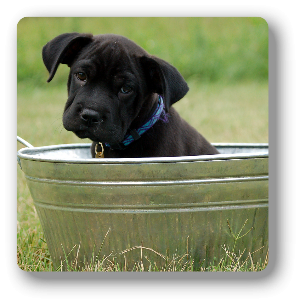 It's nice to adopt it, but then you have to feed, protect and develop it for years to come.
It's nice to adopt it, but then you have to feed, protect and develop it for years to come.
You'll need a plan. Even better, a Master Plan.
It's not that anyone requires you to have a plan, or that other owners do actually wind up implementing every detail of the plan. But it really does serve us well to have at least some context for making periodic decisions. Both sound planning and sound decisions are tightly inter-linked. If long-term master-planning is weak, the long term cumulative effectiveness of your train of small decisions will suffer. Here's how. Each year when you make decisions it can result in issues such as:
- The water line to the new barn has to go around the garage
- The overhead electric power line to the equipment shed will interfere with high-loader transit
- The new shop needs to go right on top of the septic drain field
- You can't see the horses safely in their paddock to assure they are safe.
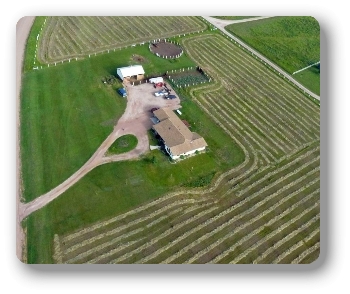 This story may help sell my case... A hobby farm or ranchette or horse property has a lot in common with a college campus (or corporate campus). A college campus has a wide spectrum of operations going on, with an equally broad array of structure types to support those operations (classroom building, office buildings, physical plant/HVAC, dorms, dining halls, gym...). Your horse property will wind up having a similarly wide array of structures and about as many different kinds of operations as a college, such as: feeding, training, weather isolation, predator protection, farrier work, milking, medical isolation,...).
This story may help sell my case... A hobby farm or ranchette or horse property has a lot in common with a college campus (or corporate campus). A college campus has a wide spectrum of operations going on, with an equally broad array of structure types to support those operations (classroom building, office buildings, physical plant/HVAC, dorms, dining halls, gym...). Your horse property will wind up having a similarly wide array of structures and about as many different kinds of operations as a college, such as: feeding, training, weather isolation, predator protection, farrier work, milking, medical isolation,...).
Every university I ever worked with had a "long term master plan." By that, I mean if you ask the dean, "What's going into those five vacant acres over in the northeast corner of campus?", you might get the answer, "A new biology classroom building is going in ten years from now, to house the biology department we hope to start up in eight years." To see some examples, just google the phrase "__ABC__ University Campus Master Plan." Believe me, universities are very good at facility-planning based on their operations planning. If you follow their lead you'll be fine. Here is the 133-page SD School of Mines and Technology (SDSM&T) 30-Year(!) Campus Master Plan as of April, 2012: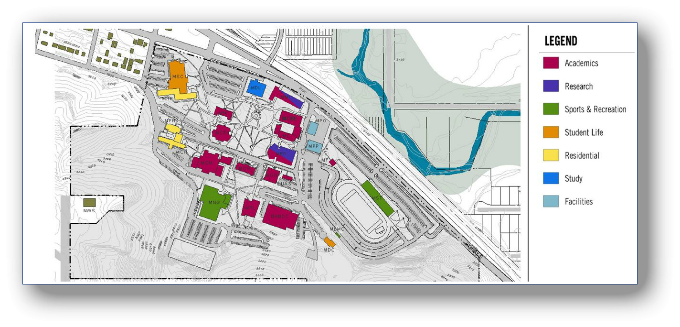
One of the worst mistakes real estate buyers can make is allowing emotion to overrule the practical facts, or perhaps even common sense. This can lead to a lack of long-term thinking, which can in turn lead to making huge mistakes (either errors of omission or errors of comission) that cause headaches and extra expense down the road.
Are you looking at enough property so that you will have room to expand later if you like? (The Black Hills in western South Dakota can be one of the best places to do that!) Will you or your children be participating in rodeos and equestrian sports, such as jumping, team penning, eventing, or dressage? If so, is there a large, level place that is big enough for a practice arena, or is there an arena already in place?
What about electricity? Electric lights, water pumps, outlets near grooming areas, and other electric amenities make living with horses a whole lot easier. If there is no electric infrastructure in place now, or is installing it later a possibility? Here are some specific "physical plant planning" issues to think ahead about (there are many, many more!):
- First, try to plan your operations, to drive facilities.
- Otherwise, your haphazard facilities will constrain your future operations (and future value of your real estate and improvements)
- Buildings, including doorway access directions
- Pedestrian trafficways
- Passenger vehicle trafficways
- Farm equipment trafficways
- Electric power cabling
- Water distribution
- Sewage treatment
- Future solar? Wind turbine tower site? (Check your state/county regulations about minimum tower distance from property line). Geothermal? Tree or building-shading of future roof solar.
- Dozens of farm animal siting issues for pens, paddocks, barns, loafing sheds,...
- Secure play areas for children
- Line of sight to pastured animals
- Hay storage near as possible to distribution system
- National Forest Service "Firewise" guidelines for structure protection
- Well proximity to paddock and barn areas
Before you buy a horse property, and before you even consider it, ask yourself what the main reason for purchasing such a property is. Ask yourself if the property you have in mind will satisfy all of your needs, and be realistic as you consider whether the property in question will enable you to continue enjoying your horses in new ways well in to the future.
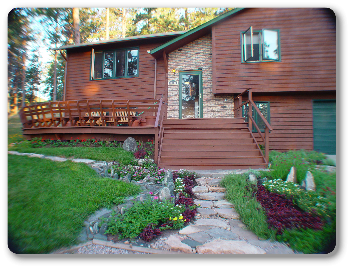 Eleven years ago my wife and I moved from east coast city-jobs to a forested acreage out west near Rapid City in the Black Hills. At first we set about 'fixing up' the home just like a typical suburban place, because that was our life style then. After 5 years we were so proud, to have slicked and spiffed out home in to tip top shape. We had leveraged the forest background as a backdrop to the best little suburban bluegrass and flowerbed lawn surrounding a suburban-looking house.
Eleven years ago my wife and I moved from east coast city-jobs to a forested acreage out west near Rapid City in the Black Hills. At first we set about 'fixing up' the home just like a typical suburban place, because that was our life style then. After 5 years we were so proud, to have slicked and spiffed out home in to tip top shape. We had leveraged the forest background as a backdrop to the best little suburban bluegrass and flowerbed lawn surrounding a suburban-looking house.
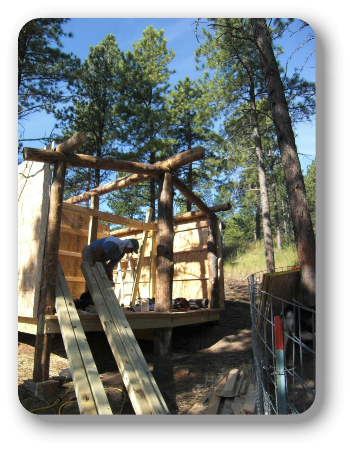 But then something happened to change all that. Rather than us permanently changing the property, it changed us. Permantly. Blissfully. Now we think and live like hobby-farm people and love every minute of it. We have six species of animals, some of them dearly adored pets, some who earn their keep. Now, we see our real estate property, and our operational use of it, more like an extension of the forest ecological system.
But then something happened to change all that. Rather than us permanently changing the property, it changed us. Permantly. Blissfully. Now we think and live like hobby-farm people and love every minute of it. We have six species of animals, some of them dearly adored pets, some who earn their keep. Now, we see our real estate property, and our operational use of it, more like an extension of the forest ecological system.
So here's my point. When you do your master plan to adapt your new horse property real estate, keep in mind that it may wind up adapting you, as you will adapt it. Not sure how to arm you to address that. But one thing for sure...
That acreage you fell in love with in adulthood, like a child infatuated with a stray puppy... it will change you as much as you will change it
- Part-1: What Makes a "Horse Property?"
- Part-2: Fences
- Part-3: Access and Vehicle Maneuvering
- Part-4: Location and Siting
- Part-5: Planning

Comments(0)